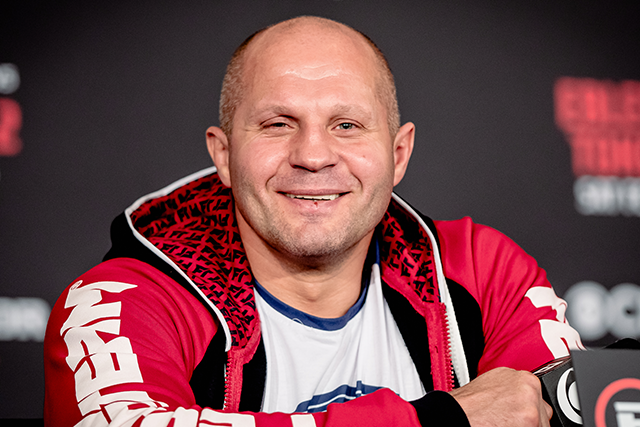Opinion: The Bellator Battle Plan

Scott Coker can alter the mixed martial arts landscape with
Bellator MMA. | Photo: Dave Mandel/Sherdog.com
Timing is everything in life, and the time is right for Scott Coker’s new strategy for Bellator MMA. He declared his intentions on scaling back Bellator’s schedule from 26 to 16 events: a show every month, plus four special big events. It feels right. Considering the proliferation of mixed martial arts cards on television today, you cannot blame the average fan for not knowing the identity of half of the fighters. Star power is everything.
With Coker and Rich Chou in control of Bellator’s matchmaking, you have to take the good with the bad. I understand why they would be interested in Gina Carano. I have no clue why they would be interested in Jason “Mayhem” Miller.
Advertisement
The timing is right for Bellator to re-launch and make a big splash. It would also appear that opportunities are opening up for Bellator in new markets. The Ultimate Fighting Championship’s policy of not working with other fight promoters has created the opening for Bellator to team up with One Fighting Championship. One FC CEO Victor Cui has done a terrific job of creating an arena-level MMA product in the Asian marketplace. Former UFC middleweight champion Rich Franklin is working with One FC management, and onetime Bellator champion Ben Askren is One FC’s biggest star. Things are looking up for the organization.
Nothing happens in a vacuum with the UFC. There is a reason why
Mark Fischer was relieved of his duties last week as UFC’s top Asia
director. The timing of Fischer’s departure a month before the
UFC’s next Saitama Super Arena show in Japan and the launch of its
new Japanese reality TV show was quite the statement. Letting go of
Fischer is not going to fix any of the UFC’s current struggles in
the Asian marketplace. He was not in control of UFC matchmaking.
The UFC has struggled to integrate its business philosophy in Asian
markets like Japan because of its business ideology. You can go
back to the failed experiment to run
Pride Fighting Championships after it bought the assets from
Nobuyuki Sakakibara. Bellator has a shot to capitalize on Zuffa’s
failures. It has an opportunity to work with an organization like
One FC, make in-roads in the Asian marketplace and, most
importantly, attract the kind of whales that gamble big money on
big fights. That is why Top Rank has close ties to the Venetian in
Macao, China. The UFC is trying to accomplish the same goal with
Cung
Le.
However, it is not just the Asian marketplace where Bellator has a chance to attack the UFC. The organization needs a multi-pronged battle plan for success. It will require some sacrifices, a smart, disciplined strategy and patience.
First, Viacom needs to maximize and utilize its current resources by encouraging crossover fights between Glory kickboxing and Bellator. The financial backers behind Glory have already proven they are willing to spend the cash to run shows whenever and wherever. Their product is appealing and easy to understand in the Asian marketplace. In Japan, the fans witnessed major fights involving K-1 and Pride talent. The same exact scenario could unfold between One FC, Glory and Bellator. You could run mixed cards or you could have fighters from both organizations cross over and do kickboxing fights. It makes a lot of sense. It would also appeal to fans in the Chinese marketplace. It is a win-win for everyone involved.
Second, Bellator needs to take advantage of the UFC’s follies in the Canadian marketplace. The UFC was on top of the world when in April 2011 it booked Georges St. Pierre-Jake Shields for the Rogers Centre in Toronto. The company returned to Toronto with Jon Jones-Alexander Gustafsson at the Air Canada Centre. However, when it came time to do the Jones-Gustafsson rematch, the UFC backed away from Toronto and took the fight to Las Vegas. You would have thought the UFC would be more confident with its footing in Canada, but apparently St. Pierre was its one-trick pony. Sure, running mid-level cards in Vancouver, British Columbia, and Halifax, Nova Scotia, is nice, but what about Calgary, Alberta? Remember the UFC’s debacle there? What about Edmonton, Alberta? I remember the Zuffa-run World Extreme Cagefighting event at Rexall Place, and it was great. How about Winnipeg, Manitoba? The UFC booked Rashad Evans-Dan Henderson there in June 2013. It is safe to say there is a lot of opportunity for a promotion not named the Ultimate Fighting Championship to start planting its flag in the very large Canadian MMA marketplace. The country’s fans deserve more respect than they have received of late.
Third, hit the East Coast market with a vengeance. Despite the fact that the UFC is running a few more events in the Eastern Time zone, the company is still largely viewed as a West Coast sport and a California-Las Vegas fight promoter. Remember when the USA Network had established venues like the Blue Horizon in Philadelphia for Tuesday Night Fights? Bellator needs to create its own East Coast hot spots from venues with some gritty, gutty fights. Eddie Alvarez -- who left Bellator for the UFC -- is a unique personality who knows what his short-term future in MMA looks like. Bellator needs more fighters like him from the East Coast, fighters that personify larger-than-life personalities and can gain traction along the Washington D.C.-Boston Acela line of big cities. Bring the passion, and bring the heat. Avoid what the UFC did by booking Ryan Bader-Ovince St. Preux in Bangor, Maine, with a post-midnight start time. Cater to the interests and needs of the East Coast fans starving for any kind of bone to be thrown their way. The Strikeforce heavyweight grand prix concept at the Izod Center in New Jersey was excellent.
Fourth, start heavily lobbying the politicians and media personalities along the Washington, D.C.-New York Acela line. You cannot expect the majority of media outlets on the East Coast to come to you and give you media exposure. You have to go to the outlets and give them a reason to care. During Marc Ratner’s tenure with the UFC as vice president of regulatory affairs, the organization has done a brilliant job, not only of lobbying politicians but also of pursuing the important decision-making media moguls who are influencers in American culture. Outside of the ongoing fiasco in New York, the UFC has greased the wheels to a great degree in big markets in California and Florida. Bellator has a similar opportunity and should follow the same path for building institutional and political support for its product. Introduce some of the company’s top stars to politicians and reporters. Help make them household names among the decision makers. Build up the important, interpersonal skills needed in communicating with those in power and those who have money. Viacom’s bank account dwarfs that of the UFC. Get in the game and schmooze with the power brokers.
Fifth, and most important, it is time for Bellator to cut the amount of different weight classes for which it currently book fights. Promoting fights in eight or 10 different weight classes is counterproductive. Even UFC President Dana White recently admitted, when talking about featherweight champion Jose Aldo, how much of a challenge it is to draw big business with fighters who are smaller than 155 pounds. In boxing, the magic weight class is at 147 pounds. No matter how great the fighters are in smaller weight classes, the public at large is not buying into what is being sold. Look at the PPV buy rates and television ratings for flyweight champion Demetrious Johnson. He is an elite fighter who is very smart and good at interviews, and yet, the general public could not care less.
Bellator should adjust accordingly, even if it means letting go of fighters like Joe Warren and Eduardo Dantas. Focus on the lightweight, welterweight, middleweight, light heavyweight, heavyweight and women’s bantamweight divisions. Restructure the roster and book as many fighters for only those weight classes. Under Richard Schaefer’s reign with Golden Boy, Showtime boxing focused on the weight classes that made money. Bellator needs to do the same. If the UFC wants to run 50 shows a year with 10 different weight classes, let it oversaturate the marketplace. As Bellator’s initial PPV buy rates indicate, fight fans are still interested in watching pay-per-views and will pay to see the right kind of card. There may be fatigue from watching too many MMA events overall, but that is not going to stop big MMA fights from still drawing great numbers.
Bottom line: Bellator needs a battle plan that adjusts to the realities of today’s global marketplace without falling into the sand trap the UFC has created for itself. There is plenty of room for optimism if you are an MMA fan looking for a real alternative. Coker is right: the Bellator you will see in the next 18 months is completely different from the Bellator that used to exist.
Related Articles








